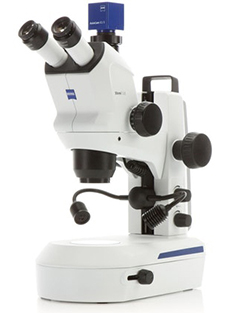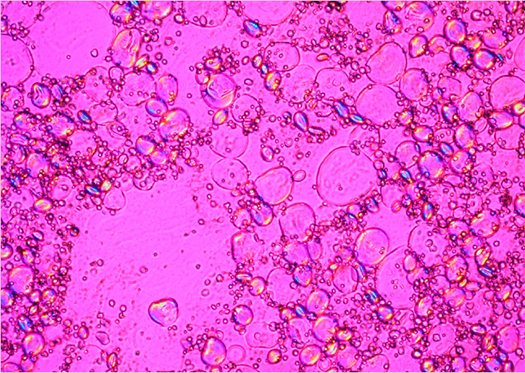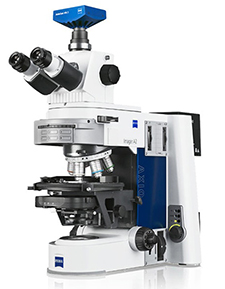Food Analysis under the Microscope
Jun 11th 2018
Foreign materials in food need to be identified with a variety of food analysis methods for safety reasons. Food analysis microscopes are used to identify ingredients that go into prepared foods, additives, as well as undesirable substances including toxins or prohibited substances including glass fragments, metals, plastics, stone or even fragments from the food itself. A microscope is used to search for fertilizer and pesticide controls. Food deterioration and preservation is also studied under a microscope. The microstructure of food is important since it affects properties, behavior at different temperatures, flavor, and texture of foods.
Stereo microscopes are used to examine foreign material in food at low magnifications. This examination provides preliminary identification of the unknown material and further analysis can be decided upon. This process also allows identification of foreign particles that may have found their way into food during manufacturing.
More extensive food analysis is performed with a light microscope equipped with brightfield, polarization and fluorescence. Some food components are birefringent, including starch, fats, plant cell walls, muscle fibers and many flavor ingredients. A polarizing microscope is invaluable for examining such crystalline substances.
In order to detect microorganisms such as bacteria, a fluorescence microscope for viewing stained samples will be useful. Gram staining is typically used to study and view bacteria such as Staphylococcus aureus, E. coli, Salmonella, Campylobacter and Shigella. Blue staining of starch with iodine is a commonly used method, as well as Fast Green FCF or Acid Fuchsin especially for the localization of proteins. Because most foods contain large amount of water and/or fat, Environmental Scanning Electron Microscopes (SEM) that enable the control of both variable pressure and moisture within the sample chamber offer great advantages for the study of food systems without the need for either freezing or drying.
A Howard Mold counting reticle or a Howard Mold Counting Chamber is often used in the eyepiece of a compound microscope when looking for mold on fruits and vegetables. This reticle provides a standard for measuring mold spores.
 A digital stereo microscope is used to analyze cereals, canned fruit and vegetables, meats, poultry and other food samples, with no special preparation. This microscope has LED illumination, which will not heat up and alter samples in any way. The microscope camera is used for documentation of foreign substances found in the food analysis process.
A digital stereo microscope is used to analyze cereals, canned fruit and vegetables, meats, poultry and other food samples, with no special preparation. This microscope has LED illumination, which will not heat up and alter samples in any way. The microscope camera is used for documentation of foreign substances found in the food analysis process.
Routine Study of Starch
Light microscopy is used to differentiate between different types of starch in the food analysis process. Different types of starch could be wheat starch, corn starch and potato starch. The granules of starch differ in their size and shape depending on the type of starch. One important aspect of starch use is their ability to produce a paste in the presence of water and heat. Any sort of tear or contamination (destruction of the starch granule), which can be easily identified with a light microscope, may have a negative impact on these gelatinization characteristics.
Starch microscopy requires the use of an upright light microscope with polarization and DIC options, such as the Zeiss Axio Lab.A1 or the Zeiss Axio Scope.A1. The routine study of starch requires 10x, 20x, and 40x objectives as well as polarization and a lambda plate. If a microscope camera is used, it will need to have sufficient dynamic range and a white balance with color channels to visualize the polarization-induced play of colors in a true-to-life manner. Routine DIC applications also require adequate camera performance. The Zeiss Axiocam ERc5s microscope camera will do the trick.
Starch Analysis Procedure:
Place a mixture of glycerin and water, which suspends the starch specimen in a thin layer, on a microscope slide and cover with a cover slip. When working with the polarization filter, the double refraction will produce polarization crosses. The characteristic double refraction is evident in nonimbibed starch granules. Increasing imbibition results in the loss of double refraction all the way to complete gelatinization of the specimen, at which point it will have disappeared completely.

This is imbibed wheat starch captured at 100x under the microscope. The image shows starch granules in different stages of imbibition, the polarization cross is not visible anymore. (Image courtesy of L. Prange, Crespel & Deiters GmbH, Germany.)
 The Zeiss Axio Imager 2 Research Microscope (shown at right) is equipped with polarization contrast and a heating stage to examine all kinds of thermal transitions such as phase transition of birefringent crystal structures, their melting characteristics and color changes in food analysis. Samples can be heated or cooled while observing under the microscope. Temperature can be documented in a time lapse series.
The Zeiss Axio Imager 2 Research Microscope (shown at right) is equipped with polarization contrast and a heating stage to examine all kinds of thermal transitions such as phase transition of birefringent crystal structures, their melting characteristics and color changes in food analysis. Samples can be heated or cooled while observing under the microscope. Temperature can be documented in a time lapse series.
If you have questions about the best microscope system for your Food Analysis requirements, contact Microscope World and we will be happy to help.





